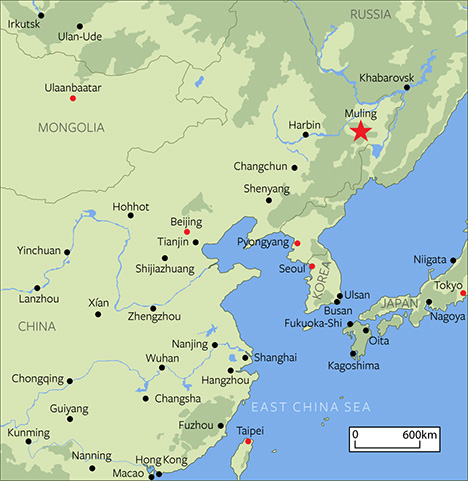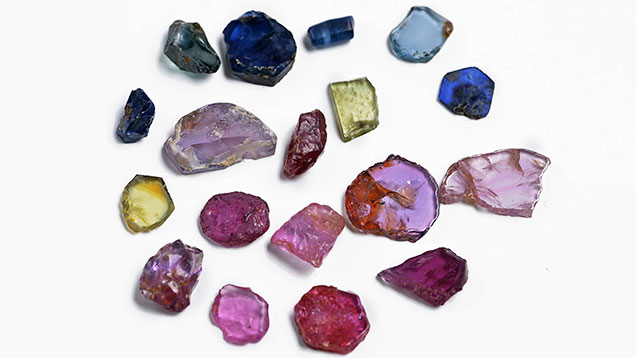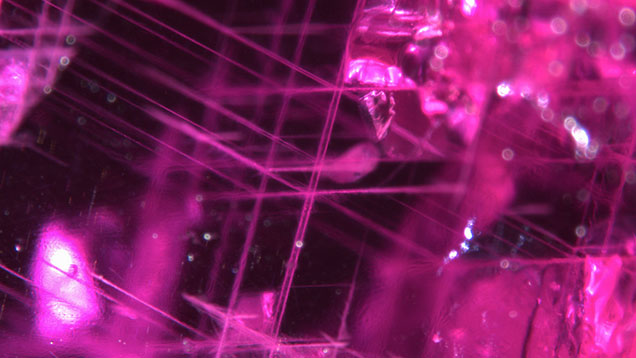Ruby and Sapphire from Muling, China

Only a few Chinese sources produce gem-quality corundum, such as Changle, in Shandong province, but sapphires from that location are not considered top quality in the trade because of their dark hues. An emerging deposit in Muling, in northeast Heilongjiang province (figure 1), produces gem-quality corundum comparable to some world-renowned sources. The main deposits are seated in mountain valleys about 70 km from the town center. Corundum was known in Muling as early as 1985; after preliminary exploration, further activity virtually stopped because of technical and logistical limitations. As a result, production has been very limited, and very little information was published about rubies and sapphires from Muling until 1995 (J.X. Sun, “Basalt related to ruby and sapphire in eastern Heilongjiang and reconstruction of paleovolcanic mechanism,” Acta Petrologica et Mineralogica, Vol. 14, No. 2, 1995, pp. 126–132).
According to Aijun Yi, director of mineral resource administration in Muling, the region has produced large amounts of gem-quality eluvial materials since 1994, including corundum, brownish red zircon, garnet, and spinel (T. Chen et al., “Brownish red zircon from Muling, China,” Spring 2011 G&G, pp. 36–41). As colored stones became more popular in the Chinese gem markets, interest in ruby and sapphire from Muling grew accordingly.
We acquired a parcel of rubies and sapphires from local miners. The stones ranged from 0.8 to 15.2 ct (figure 2). Most exhibited well-formed tabular hexagonal crystals, though some broken sapphires had a tumbled appearance. The sapphires were pink, yellow, violetish blue, greenish blue, light blue, and deep blue; there were also near-colorless specimens. Most of the rubies and pink sapphires had a purplish component. Samples other than the deep blue material showed high transparency. Rubies and pink sapphires exhibited medium red fluorescence under long-wave (356 nm) UV light and a weak reaction under short-wave (245 nm) UV. Other varieties of sapphire had no reaction under long- or short-wave UV.

The samples generally showed abraded features and unhealed fissures, but some were predominantly clean under the loupe and large enough to be faceted. Fourteen stones were fabricated as parallel polished windows for microscopic examination. Several interesting internal features were visible under the microscope. The inclusions, which mainly appeared as rounded single crystals or multiphase syngenetic clusters, were in micron sizes (50–200 µm) and were identified by Raman as feldspar and sillimanite. The latter mineral only occurred as component mineral crystals in a multiphase inclusion. Most rubies hosted whitish needles forming three-dimensional skeleton networks that might be the result of diaspore exsolution (figure 3). Further microscopic observations under polarized light showed characteristic lamellar twining structures in every sample.

Trace element analysis by LA-ICP-MS showed a Cr content of 173–636 ppma in the pink-red series, accompanied by a significant level of Fe (1650–2510 ppma) and a noticeable level of Ti (36–70 ppma) to add a blue component through Fe-Ti intervalence charge transfer. This explained why Muling rubies and pink sapphires always had a purplish hue. Mg content was about 46–79 ppma, while Ga (13–17 ppma) fell into the expected range for natural corundum.
Yellow sapphires showed the highest Fe content (4480–4800 ppma); this contributed to their saturated yellow coloration. Iron content was much lower in blue sapphires, along with an appreciable amount of titanium (80–500 ppma) as a blue chromophore. Based on color distribution and transparency, blue sapphires could be grouped as either light blue or deep blue. Most of the light blue sapphires had very high transparency and even color distribution, while deep blue sapphires were less transparent, with hexagonal dark blue color zoning. Among all blue samples, Mg content ranged from 10 to 80 ppma and did not show clear correlation to color, while Ga content (10 to 100 ppma) was noticeably higher than in rubies and pink sapphires.
At Muling, most rubies and sapphires are found by casual surface digging. Gem-quality corundum usually occurs in eluvial deposits derived from weathered Cenozoic alkali basalts. Unlike other igneous-related deposits known for dark blue sapphires and very limited red material, such as Australia’s Anakie and New England fields (T. Coldham, “Sapphires from Australia,” Fall 1985 G&G, pp. 130–146) and Shandong, China (C. Simonet. et al., “A classification of gem corundum deposits aimed towards gem exploration,” Ore Geology Reviews, Vol. 34, 2008, pp. 127–133), in Muling ruby production was larger than that of sapphire; over 60% of pink sapphires and rubies were high-quality materials.
In some ways, some Muling rubies have competitive advantages over Mozambique specimens. Their high color saturations and particular internal features (whitish needles forming three-dimensional skeleton networks) resembled those of rubies from Mozambique and might cause confusion in gem markets. On the other hand, blue sapphires from Muling have a pure blue color with no gray component. The variety of colors and the amount of fancy sapphires found in Muling are quite different from sapphires from other classic igneous deposits (see again Simonet et al., 2008).
At present, the precise location of the Muling gem deposit source rocks has not been confirmed. According to previous geological studies, the area is localized in the northern terminal of the branch of the Tanlu fault (Z. L. Qiu et al., “Trace element and hafnium isotopes of Cenozoic basalt-related zircon megacrysts at Muling, Heilongjiang Province, northeast China,” Acta Petrologica Sinica, Vol. 23, No. 2, 2007, pp. 481–492). The lava in this region can be divided into six volcanic eruption cycles; Muling has experienced three such cycles (Sun et al., 2005).
Based on mining and geological information and our analysis of Muling rubies and sapphires, we inferred that this material might have originated as xenocrysts from an earlier volcanic eruption and undergone subsequent high-pressure geological processes. These are likely non-classic alkali basalt deposits. Large corundum deposits exist from eastern China to Primorye in far eastern Russia (I. Graham et al., “Advances in our understanding of the gem corundum deposits of the West Pacific continental margins intraplate basaltic fields,” Ore Geology Reviews, Vol. 34, pp. 200–215), but exact locations have not been confirmed.
Although Muling’s corundum deposit have yet to be mined commercially, the existing production has drawn the attention of Chinese gemologists and gem dealers. The production may rival that from other high-quality deposits, and this source holds great promise for the future.



